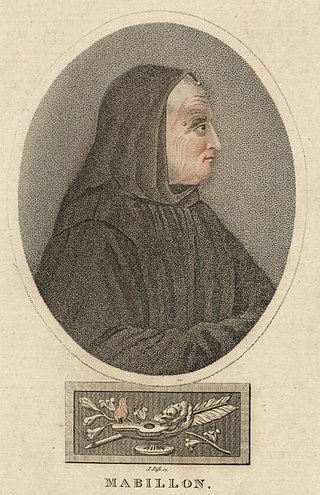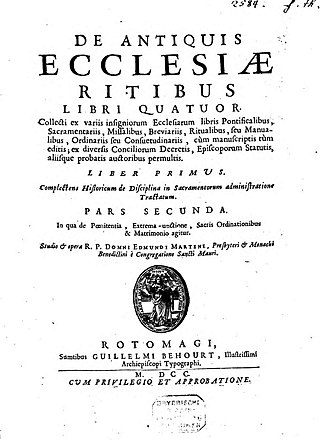Related Research Articles

Dom Jean Mabillon, O.S.B., was a French Benedictine monk and scholar of the Congregation of Saint Maur. He is considered the founder of the disciplines of palaeography and diplomatics.
Luc d'Achery was a learned French Benedictine of the Congregation of St. Maur, a specialist in the study and publication of medieval manuscripts.
Martin Bouquet was a French Benedictine monk and historian, of the Catholic Congregation of St.-Maur. His major work was Rerum Gallicarum et Francicarum Scriptores, a collection of the historians of Gaul and France, which covers the time from France's earliest history until the year 987.

René-Prosper Tassin was a French historian, belonging to the Benedictine Congregation of Saint-Maur.
Charles-François Toustain was a French historian and a member of the Benedictine Congregation of Saint Maur. He is remembered for his scholarly work carried out with his fellow Maurist, Dom René-Prosper Tassin.

Edmond Martène was a French Benedictine historian and liturgist.

Dom Thierry Ruinart (1657–1709) was a French Benedictine monk and scholar. He was a Maurist, and a disciple of Jean Mabillon. Of his many works, the one now cited is his Acta sincera, a martyrology, written in Latin. His work is one of the main sources of Alphonsus Liguori's "Victories of the Martyrs". He was also interested in oenology. In 1729 his nephew Nicolas Ruinart founded the champagne house of Ruinart, which operates to this day (2007).
Ursin Durand was a French Benedictine of the Maurist Congregation, and historian.
Claude Chantelou was a Benedictine Patristic scholar and writer.
Pierre Coustant was a French Benedictine scholar, of the Congregation of Saint-Maur.
François Lamy was a French Benedictine ascetical and apologetic writer, of the Congregation of St-Maur.
François Clement was a French historian and member of the Benedictine Congregation of St. Maur.
The Congregation of St. Vanne or Congregation of St. Vanne and St. Hydulphe (French: Congrégation de Saint-Vanne et Saint-Hydulphe was a Benedictine reform movement centered in the Duchy of Lorraine. It was formally established in 1604 on the initiative of Dom Didier de La Cour, prior of the Abbey of Saint-Vanne near Verdun, a reformer of the Benedictine Order after the Council of Trent. The Abbey of St. Hydulphe at Moyenmoutier was a secondary centre of the reform.
Prudentius Maran (14 October 1683, at Sezanne, Marne – 2 April 1762, at Paris) was a French Benedictine scholar of the Maurist Congregation, known as a patrologist.
Antoine-Augustin Touttée was a French Benedictine scholar of the Maurist Congregation.
François Delfau was a French Benedictine theologian, an authority on patristic theology.
Robert Guérard was a French Benedictine scholar of the Congregation of St. Maur.
Claude Estiennot de la Serre was a French Benedictine scholar of the Congregation of Saint-Maur.
Dom Joseph Vaissète was a scholarly French Benedictine monk who wrote a history of Languedoc and a geography of the world as it was known in his day. Vaissette's Histoire générale de Languedoc is still considered a work of great erudition and value by modern historians. The Geography had its faults from lack of technology, but was the most detailed and accurate of its day. Some names for the volume differ from modern usage. Because of this, he gives the name La Côte des Dents to what is now the Côte d'Ivoire.
The Monasticon Gallicanum is a collection of 168 engravings of topographical views, with two maps, representing 147 monasteries in France belonging to the reformist Congregation of St. Maur within the Order of St. Benedict, prepared between 1675 and 1694, when Dom Michel Germain, who commissioned them, died, but not published in full until 1870.
References
Citations
- ↑ Knowles, M.D. (1959). "Presidential Address: Great Historical Enterprises II. The Maurists". Transactions of the Royal Historical Society. 5th ser. 9: 169–187. doi:10.2307/3678810. JSTOR 3678810.
- 1 2 3 4 5 6 7 8 9 10 One or more of the preceding sentences incorporates text from a publication now in the public domain : Butler, Edward Cuthbert (1911). "Maurists". In Chisholm, Hugh (ed.). Encyclopædia Britannica . Vol. 17 (11th ed.). Cambridge University Press. p. 911.
- ↑ Alston, Cyprian (1907). . In Herbermann, Charles (ed.). Catholic Encyclopedia . Vol. 2. New York: Robert Appleton Company.
- ↑ Toke, Leslie Alexander St. Lawrence (1911). . In Herbermann, Charles (ed.). Catholic Encyclopedia . Vol. 10. New York: Robert Appleton Company.
Sources
The chief source of information on the Maurists and their work is Dom Tassin's Histoire littéraire de la Congrégation de Saint-Maur (1770); it has been reduced to a bare bibliography and completed by de Lama, Bibliothèque des écrivains de la congrégation de Saint-Maur (Münich and Paris, 1882). The two works of de Broglie, Mabillon (2 vols., 1888) and Montfaucon (2 vols., 1891), give a picture of the life of the great Maurists of the earlier generation. Sketches of the lives of a few of the chief Maurists will be found in McCarthy's Principal Writers of the Congregation of S. M. (1868).
Useful information about their literary undertakings will be found in Léopold Delisle's Le Cabinet des manuscrits de la Bibliothèque impériale; Fond's Saint-Germain-des-Prés. General information will be found in the standard authorities: Helyot, Histoire des ordres religieux (1718), vi. c. 37; Heimbucher, Orden und Kongregationen (1907) i. 36; Wetzer und Welte, Kirchenlexicon (ed. 2) and Herzog-Hauck's Realencyklopädie (ed. 3), the latter an appreciation by the Protestant historian Otto Zückler.